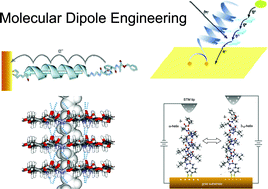Molecular dipole engineering: new aspects of molecular dipoles in molecular architecture and their functions
Abstract
The assembly of molecular architectures on the basis of molecular dipoles is proposed here to be a promising tool for construction of nanomaterials and nanodevices. Three kinds of building blocks having dipoles are discussed; helical peptides, cyclic β-peptides, and oligo(phenylene ethynylene)s having donor and acceptor substituents. Secondary interactions involving molecular dipoles are shown to be effective to control precise molecular shapes and to assemble the building blocks in a regular manner. Furthermore, molecular dipoles can generate a strong electric field at the nanoscale, which is useful for the promotion or suppression of electron transfer processes. Organic molecules with strong dipoles will therefore be applicable to various fields, such as molecular electronics and medical chemistry, as functional nanomaterials. It is expected that the chemistry of dipolar molecules will lay a firm foundation for a new interdisciplinary field, that of “molecular dipole engineering”.


 Please wait while we load your content...
Please wait while we load your content...